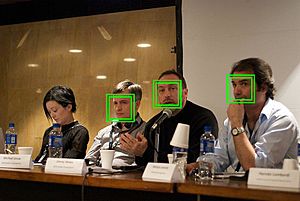Face detection facts for kids
Face detection is a special computer skill that helps computers find and recognize human faces in pictures or videos. It's like teaching a computer to spot a face in a crowd! This technology doesn't figure out who the person is, but it simply confirms that a face is present.
Contents
What is Face Detection?
Face detection is a type of artificial intelligence (AI) that focuses on finding human faces. Imagine a computer looking at a photo. Face detection helps it draw a box around every face it sees. It's different from face recognition, which tries to identify who the face belongs to. Think of it this way: detection finds the face, recognition names it.
How Does Face Detection Work?
Computers use special programs and algorithms to detect faces. These programs are trained with many pictures of faces and non-faces. They learn to look for common features that all human faces share.
- Looking for patterns: The computer searches for patterns like the shape of eyes, nose, and mouth. It also considers how these features are spaced out.
- Using light and shadow: Faces often have certain light and shadow patterns. The computer can use these clues to find a face.
- Different methods: There are many ways computers do this. Some methods look at the edges and lines of a face. Others use machine learning to predict where a face might be.
Steps in Face Detection
When a computer tries to find a face, it often follows a few steps:
- Scan the image: The computer scans the entire picture or video frame.
- Find potential areas: It looks for areas that might contain a face. These areas might have skin color or certain shapes.
- Check for features: Inside these areas, it checks for specific facial features like eyes, nose, and mouth.
- Confirm the face: If enough features are found in the right places, the computer confirms it's a face. It then often puts a box around it.
Where Is Face Detection Used?
Face detection is used in many everyday technologies. It makes our lives easier and safer in several ways.
- Smartphone cameras: When you take a photo, your phone often detects faces to make sure they are in focus. This helps your pictures look clear and sharp.
- Social media: Apps like Facebook or Instagram use face detection to suggest tagging friends in photos.
- Security cameras: Some security systems use face detection to spot people in a crowd. This helps them monitor areas more effectively.
- Video games: Some games use face detection to allow players to control characters with their head movements.
- Marketing and retail: Stores might use face detection to count how many people look at a certain display. This helps them understand what customers like.
- Car safety: In some modern cars, face detection can check if the driver is paying attention or falling asleep.
History of Face Detection
The idea of teaching computers to see faces started many years ago. Early attempts were simple and not very accurate.
- Early research: In the 1960s, scientists began exploring how computers could recognize patterns.
- Breakthroughs in the 1990s: Major progress happened in the 1990s with new algorithms. One famous method is called the Viola–Jones object detection framework, developed in 2001. This method made face detection much faster and more reliable.
- Modern advancements: Today, with powerful computers and advanced deep learning techniques, face detection is very fast and accurate. It can even work in difficult conditions, like low light.
Challenges in Face Detection
Even with all the progress, face detection can still be tricky.
- Lighting: Too much or too little light can make it hard for computers to see faces.
- Angles and poses: If a face is turned away or tilted, it can be harder to detect.
- Obstructions: Things like hats, scarves, or even hands covering part of the face can confuse the system.
- Expressions: Different facial expressions, like smiling or frowning, can also make detection harder.
- Age and appearance: Faces change with age, and different hairstyles or makeup can also affect detection.
The Future of Face Detection
Face detection technology is always improving. Scientists and engineers are working to make it even better.
- More accuracy: Future systems will be even better at finding faces in tough conditions.
- Faster processing: They will be able to detect faces almost instantly, even in live video streams.
- New applications: We might see face detection used in even more new and exciting ways, from helping people with disabilities to making smart homes even smarter.
See also
 In Spanish: Detección de caras para niños
In Spanish: Detección de caras para niños


